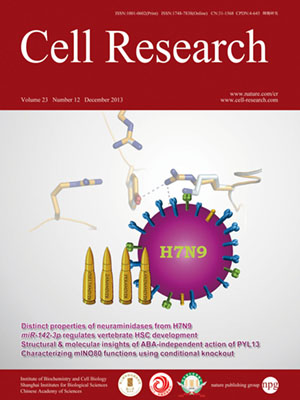
Volume 23, No 12, Dec 2013
ISSN: 1001-0602
EISSN: 1748-7838 2018
impact factor 17.848*
(Clarivate Analytics, 2019)
Volume 23 Issue 12, December 2013: 1369-1379
ORIGINAL ARTICLES
Molecular basis for the selective and ABA-independent inhibition of PP2CA by PYL13
Wenqi Li1,2,3,*, Li Wang3,*, Xinlei Sheng1,2,3,*, Chuangye Yan1,2,3, Rui Zhou1,2,3, Jing Hang1,2,3, Ping Yin1,2,3 and Nieng Yan1,2,3
1State Key Laboratory of Bio-membrane and Membrane Biotechnology, Tsinghua University, Beijing 100084, China
2Center for Structural Biology, School of Medicine and School of Life Sciences, Tsinghua University, Beijing 100084, China
3Tsinghua-Peking Center for Life Sciences, Tsinghua University, Beijing 100084, China
Correspondence: Nieng Yan,(nyan@tsinghua.edu.cn)
PYR1/PYL/RCAR family proteins (PYLs) are well-characterized abscisic acid (ABA) receptors. Among the 14 PYL members in Arabidopsis thaliana, PYL13 is ABA irresponsive and its function has remained elusive. Here, we show that PYL13 selectively inhibits the phosphatase activity of PP2CA independent of ABA. The crystal structure of PYL13-PP2CA complex, which was determined at 2.4 Å resolution, elucidates the molecular basis for the specific recognition between PP2CA and PYL13. In addition to the canonical interactions between PYLs and PP2Cs, an extra interface is identified involving an element in the vicinity of a previously uncharacterized CCCH zinc-finger (ZF) motif in PP2CA. Sequence blast identified another 56 ZF-containing PP2Cs, all of which are from plants. The structure also reveals the molecular determinants for the ABA irresponsiveness of PYL13. Finally, biochemical analysis suggests that PYL13 may hetero-oligomerize with PYL10. These two PYLs antagonize each other in their respective ABA-independent inhibitions of PP2Cs. The biochemical and structural studies provide important insights into the function of PYL13 in the stress response of plant and set up a foundation for future biotechnological applications of PYL13.
10.1038/cr.2013.143
FULL TEXT | PDF
Browse 2333


